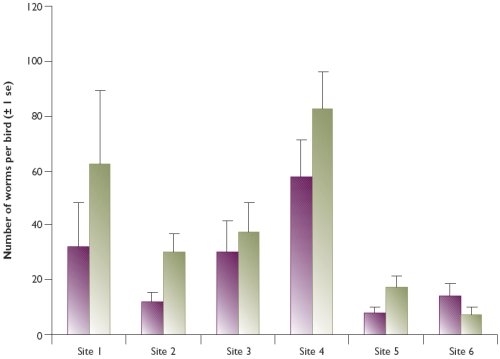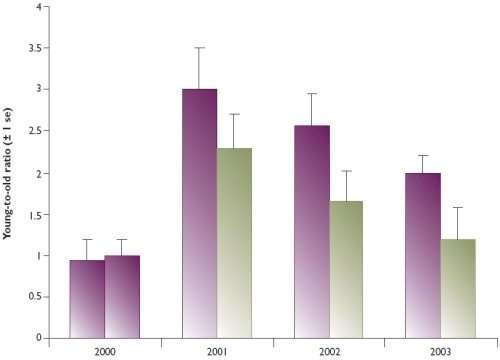Key findings
- Pheasant breeding success was better among birds fed wormer-treated grain than those eating non-treated grain.
- There were 15-50% more chicks observed on the plots with treated grain.
- Spring wormer treatments can reduce worm burdens in pheasants and lead to higher breeding success.
In 2003 we completed the final year of our field trial investigating the impact of parasitic worms on the survival and breeding success of pheasants. In Britain, parasitic worm infection is widespread in pheasants, with the most common parasites being Heterakis gallinarum, gapeworm (Syngamus trachea) and Capillaria species. Our previous research on a single study site showed that these parasites can reduce survival and breeding success in pheasants.
The parasites' eggs can remain viable in the soil for several years and can build up in areas where pheasants congregate, such as release pens, near feeding points and in holding woods. Our work with spring feeding (see Review of 2000), showed that the next logical step was to combine feeding with an anthelmintic dosing treatment to determine whether breeding success could be improved.
We started our field trial in 2000, with nine sites in Norfolk participating in the study. On each site we had two study plots, which were approximately 300 hectares each. In the first year we gave a wormer treatment to all pheasants. In the second and subsequent years in early spring we provided treated grain (treated with the worming drug, Flubenvet) to pheasants via feed hoppers in one of the plots on each site. Meanwhile we provided ordinary untreated grain in the remaining plots. We counted pheasant numbers in spring and autumn to assess survival and productivity and we counted parasites from birds collected each shooting season from each plot.
In April 2003, we placed parasite-free hen pheasants in pens in the treated areas (ie. where Flubenvet-treated grain was provided) and control plots, moving the pens twice weekly for 30 days to maximise exposure to the soil. We then conducted post-mortem examinations on the birds to check for the presence of parasites and assess the effect of the four-year treatment on environmental worm levels. Over 98% of birds were infected with H. gallinarum, 63% of birds were infected with Capillaria species and around 10% were infected with gapeworm. We did not find any evidence of tapeworm infection. These results reveal the high prevalence of the parasites in the environment.
However, when we compared the worm burdens of the most prevalent and abundant worm, H. gallinarum, in birds held in treated versus untreated plots, there were significantly fewer worms in the treatment group (see Figure 1). In the birds collected in winter on shoot days, worm burdens were around 10% lower in birds from treated plots, although this difference was not significant. This was perhaps to be expected as we collected these birds nine months after treatment, allowing time for re-infection.
Figure 1: Burdens of Heterakis gallinarum in penned hen pheasants placed in plots where Flubenvet treated grain was provided and untreated plots, April 2003

The results from the game counts showed that breeding success (in terms of young-to-old ratio) was significantly higher in birds from the treated plots in 2002 and 2003 (see Figure 2). This improved breeding success resulted in between 15% and 50% more young birds observed in the treated plots. Our results show that in some situations a spring wormer treatment can significantly reduce environmental parasite burdens, which can lead to increases in pheasant breeding success. This research will help us to develop practical prescriptions for the control of parasites in free-living pheasants that can be used by gamekeepers and shoot managers.
Figure 2: Productivity (young-to-old ratio) of pheasants in plots where Flubenvet-treated grain was provided and untreated plots

Note: In 2000 feeders in all plots had Flubenvet added.
Get the Latest News & Advice
Join over 100,000 subscribers and stay updated on our latest advice, research, news and offers.
*You may change your mind any time. For more information, see our Privacy Policy.